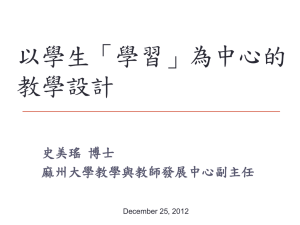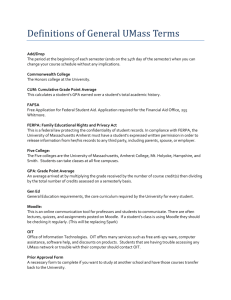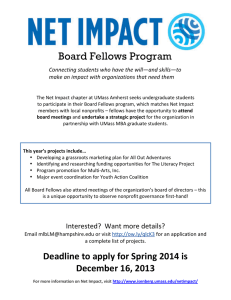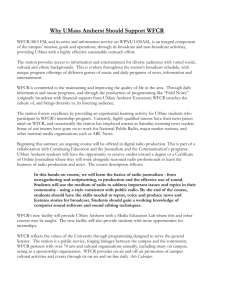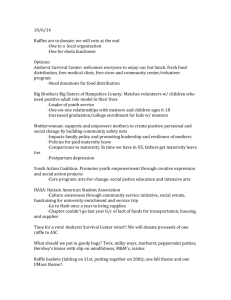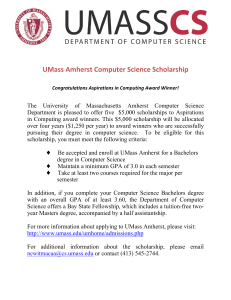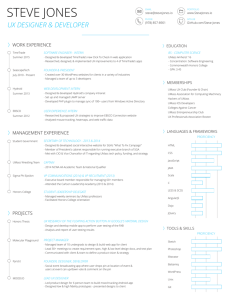A Student Reference for Sustainability at UMass Abstract
advertisement
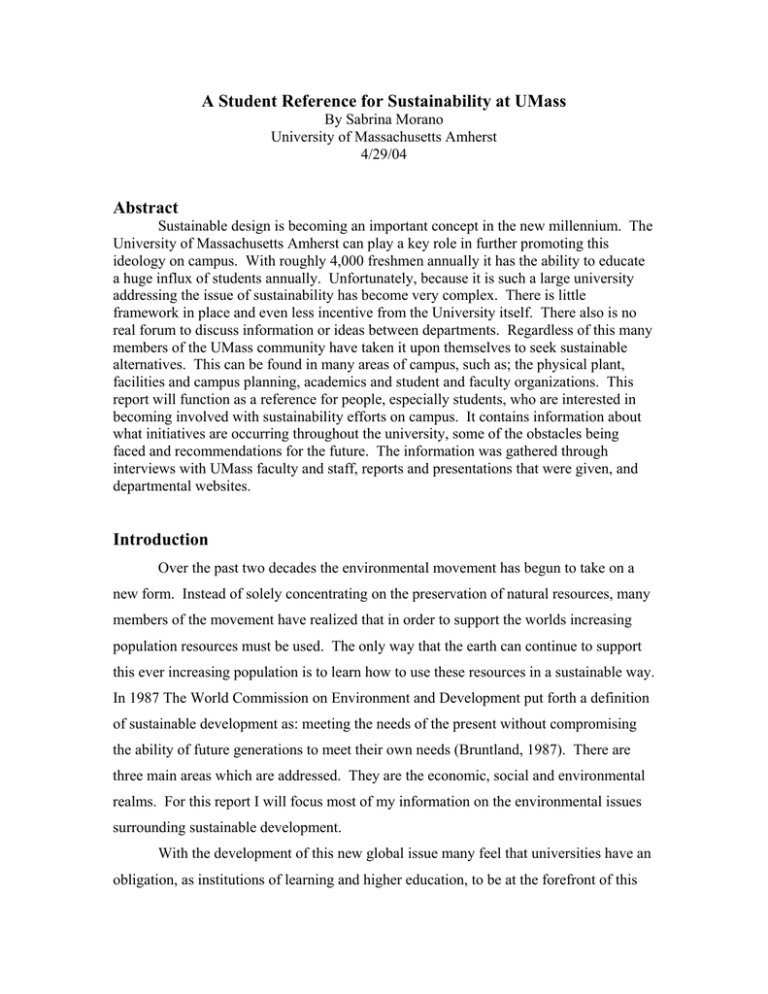
A Student Reference for Sustainability at UMass By Sabrina Morano University of Massachusetts Amherst 4/29/04 Abstract Sustainable design is becoming an important concept in the new millennium. The University of Massachusetts Amherst can play a key role in further promoting this ideology on campus. With roughly 4,000 freshmen annually it has the ability to educate a huge influx of students annually. Unfortunately, because it is such a large university addressing the issue of sustainability has become very complex. There is little framework in place and even less incentive from the University itself. There also is no real forum to discuss information or ideas between departments. Regardless of this many members of the UMass community have taken it upon themselves to seek sustainable alternatives. This can be found in many areas of campus, such as; the physical plant, facilities and campus planning, academics and student and faculty organizations. This report will function as a reference for people, especially students, who are interested in becoming involved with sustainability efforts on campus. It contains information about what initiatives are occurring throughout the university, some of the obstacles being faced and recommendations for the future. The information was gathered through interviews with UMass faculty and staff, reports and presentations that were given, and departmental websites. Introduction Over the past two decades the environmental movement has begun to take on a new form. Instead of solely concentrating on the preservation of natural resources, many members of the movement have realized that in order to support the worlds increasing population resources must be used. The only way that the earth can continue to support this ever increasing population is to learn how to use these resources in a sustainable way. In 1987 The World Commission on Environment and Development put forth a definition of sustainable development as: meeting the needs of the present without compromising the ability of future generations to meet their own needs (Bruntland, 1987). There are three main areas which are addressed. They are the economic, social and environmental realms. For this report I will focus most of my information on the environmental issues surrounding sustainable development. With the development of this new global issue many feel that universities have an obligation, as institutions of learning and higher education, to be at the forefront of this movement. I agree with Comments made by Professor Emeritus of Astronomy at Smith College, Richard E White (2002). In a report on Sustainability at Smith College he wrote, “Colleges and universities train the leaders of the next generation, so it is imperative that students discover the nature of this challenge, learn the best current thinking on how to meet it, and develop the skills to enable them to search creatively for solutions, as well as to work in society to implement them (pg1).” He also stated that unlike the government and commerce, universities “operate on visions for the long term,” this would allow them to more effectively deal with the issue of sustainable development and future generations. The University of Massachusetts has an even greater opportunity to create change. With an undergraduate enrollment of over 17,000 students it has the ability to reach an even larger, more diverse audience. It’s also been shown that public universities produce a larger percentage of students who remain in the state and become part of the working class. If these students learn some of the principles of sustainability while at UMass there is a greater chance that they will take that knowledge with them to their future occupations. Unfortunately, addressing the issue of sustainability for a large university is a very complex matter. It becomes an even bigger problem at UMass because there is no framework in place and there is little support from the administration. This is not to say that efforts to foster sustainability on campus do not exist. Many sectors of the UMass community have taken it upon themselves to seek sustainable alternatives, or even incorporate this ideal into their teaching. The two things that are lacking are communication and motivation. There are many people with great ideas but there is no forum in which to discuss them or a real understanding about what initiatives are taking place. Also, there is little incentive for faculty or staff to move in a more sustainable direction. Personally I believe that students must work as a motivating force for the sustainability movement on campus. Since one of the major obstacles is money, students can provide a much needed resource, “cheap labor.” Two years ago I was involved in the development of a group called Students for Sustainability (SFS). We had a very broad mission statement which was essentially to work on sustainability issues on campus. The two things that became the most difficult were developing a membership base and getting a firm grasp of current initiatives on campus. Because of the clubs juvenility, broad objectives and difficulty in attracting members we ended up overextending ourselves, which led to the eventual dissipation of the club. As a result of this I have had first hand experience with how difficult it is to develop a new student organization. It took us a long time to get the background information together before we could even start being active. Now that the original members are gone, a new group would have to start once again from scratch. The purpose of this report is to create a reference for any group or individual interested in becoming involved with sustainability at UMass. What I have done is gathered as much information as possible within the time given and compile it into a single source. The information is grouped into three sections. The first is a summary of initiatives on campus; including courses, research, facility improvements, organizations etc. The second includes some of the comments made by various members of the UMass community. It also includes recommendations for the future. The third is an appendix of people to contact within the university and also UMass research programs which deal with sustainable development. Methodology Information pertaining to sustainability initiatives on campus was gathered through personal interviews with UMass faculty and staff, reports, presentations, and departmental websites. The Information will fall into one of four sections 1) Physical Plant and Operations, 2) Facilities and Campus Planning, 3) Academic Programs and 4) Student /Faculty Organizations. A person representing each sector of the University was interviewed. Steve Goodwin, Assoc. Dean for the College of Natural Resources and the Environment was interviewed to gain information on the faculty senate and administration’s views. John Gerber, professor of Plant and Soil Sciences, was interviewed because of his involvement in sustainability from the faculty/professor perspective. John Pepi, solid waste manager for the building and grounds department, was interviewed to gain information on physical plant operations and waste management. Ludmilla Pavlova, Facilities Planner and Jim Cahill, Director of Facilities and Campus Planning, were interviewed to gain information on Campus and Facilities planning, namely landscaping and construction. Students were also questioned to gather information on what changes they would like to see on campus in terms of sustainable development. John Gerber’s plant and soil sciences class 290S “Sustainable Living” were asked two questions. They were “What is one thing that needs to be changed on campus that would help move it toward a more sustainable future?” and “What is one way that you feel students could get involved with making these changes?” There responses will be included in the discussion section of this report. Results Physical Plant and Operations: The Physical Plant is coming up with creative ways to deal with the waste and energy needs of such a large University. The Office of Waste Management (OWM), a subset of the Physical Plant, has created a comprehensive and effective recycling program that serves as a national model among institutions of higher education. They have invested $1Million in an Intermediate Processing Facility. This has helped to create the university’s 57% recycling rate. In Fiscal Year 2003 UMass recycled 4,900 tons of material from its total 7,361 tons of waste produced. 1 The University not only recycles paper/cardboard and mixed containers, it also recieves certain appliances, batteries, books, clothes, florescent tubes, furniture, paint, refrigeration units, styrofoam peanuts, ink cartridges and tires. The University accepts materials from campus, but also the community. In fiscal year 2003 they processed 1,218 tons of recycled material for the community. UMass received the Wright Environmental In-Vessel-Composter Grant for $90K from DEP to create its composting facility. 2 It accepts food waste, woodchips and horse bedding. The system is constructed to eliminate odor so it’s acceptable in more urban settings. Currently the university uses this material for rebedding shrubs, lawns and planters. It has saved the university money by eliminating its need to purchase loam and has created money through the sale of 1,393 4-Gallon tubs of material to the 1 2 http://www.umass.edu/recycle/progress_goals.html - “Progress Toward Recycling Goals” http://www.umass.edu/recycle/destinations_and_vendors.html community. The Office also received a $45,000 grant from the EPA and DEP to serve as a regional collection center for electronics demanufacturing. Cash for Trash is a UMass-sponsored recycling program started in March 2004 which is a collaboration between the UCard Office and the Office of Waste Management in partnership with C3 Recycling Systems. For each cell phone and Inkjet/Laser Toner cartridge students recycle, one dollar will be deposited into their UCard debit account. Shipping of the items will be covered by C3 Recycling Systems. Currently, over 130 people have registered for the program. 3 The office of waste management has also held information sessions about the benefits of recycling and how to recycle on campus. They have a display which consists of a 3,500lb pile of garbage which demonstrates how much garbage UMass Students produce daily. Aside from recycling the Physical plant also works on ways to reduce the initial use of resources. This is done through green procurement, especially in the areas of recycled plastic lumber (benches, picnic tables, recycling/trash collection containers and planters) and recycled content paper (university letterhead printed on 50/30recycled paper). UMass has a fleet of over 500 vehicles ranging from heavy construction equipment to sedans and 30 electric vehicles, a fuel depot, and several maintenance garages. Because of this, environmental issues associated with its operations are substantial. To effectively manage those issues and benefit the environment, Fleet Services implemented a pilot program which began in July of 2003 involving an Environmental Management System. EMS is a business tool that provides a systematic approach to addressing environmental issues within organizations. 4 The decision to implement an EMS within Fleet Services was prompted in part by the results of an Environmental Protection Agency compliance 3 http://www.umass.edu/ucard/Cashfortrash.html - “Cash for trash” http://www.umass.edu/newsoffice/archive/2002/103102ems.html - “UMass Pilot Program will Benefit Environment” 4 inspection in 2000. As part of its agreement with EPA following that inspection, the campus announced its plan to implement an EMS within Fleet Services. The University also adopts the practice of urban integrated pest management. This is a solution for reducing pests, which de-emphasizes the use of pesticides as the principal control strategy. This program is a collaboration between Landscape Services and UMass Extension. The Physical Plant will be beginning a large energy conservation project ($50 to $80 million in capital improvement) which is proposed to be funded by utility savings over a 10 or 20 year period. 5 A key goal of the project is to improve building performance in conjunction while saving on operating costs. Since the contractor will guarantee the performance of the measures, the agreement is commonly called a performance contract. Some of the more obvious components will be lighting and lighting controls, new chillers and other building mechanical improvements, water conservation measures including low flow toilets, and steam and electric distribution improvements including building metering. The proposal was selected to maximize these improvements so that the buildings will be modified and operated to provide better lighting, heating, cooling and ventilation for building occupants. Efficiency improvements and turning things off during unoccupied hours are the key strategies. These modifications will be coupled with various outreach programs to reinforce the economic and environmental importance of energy and water conservation in the campus community. Facilities & Campus Planning: Buildings and new construction have great Impacts on the environment. They also require the use of large amounts of raw materials. The Office of Facilities and Campus Planning has created many options for dealing with these issues. Unfortunately they are not LEEDS (Leadership in Energy & Environmental Design) certified but they have the desire to move in that direction. Although, they attempt to incorporate some of the green 5 http://www.facil.umass.edu/~utildept/html/projects/EnergyProject/index.html - “Energy Performance Contract” building standards into the designs for new construction it is often difficult because of time and money constraints. Yet, as an attempt to foster these principles, office members are often sent to LEEDS training workshops. They are also members of the US Green Buildings Council which helps the office to keep up to date with the latest information. 6 Thankfully the state of Massachusetts has very strict building code requirements. It is mandatory that every plan show explicit energy efficiency measures. The University makes sure that each building fully complies with these guidelines. The office of Campus Planning has also erected several photovoltaic street lamps around many of the campus parking lots. They are able to receive all the energy needed from these cells. There is also a proposal to place a solar panel on the visitor’s center, as not only a way to supply energy to the building, but also as an educational tool for families visiting the campus. The most innovative development that the office will undertake beginning within the next few months is the construction of a new Central Heating Plant. The new plant, which will burn both fuel oil and natural gas, will replace the outdated plant that primarily burns coal, with oil and natural gas used to supplement the coal firing. The Director of Facilities and Campus Planning, Jim Cahill spoke about the many benefits of the new plant. He noted that "By replacing the existing, 60-year-old heating plant and co-locating it with the wastewater treatment facility, the new heating plant will significantly conserve natural resources and reduce greenhouse gas and ozone-producing air emissions, while providing steam and electric energy to the campus both reliably and economically." He also stated that substantial reduction in air pollutants will result from the elimination of coal burning and sulfur dioxide emissions will be cut by nearly a half million pounds per year from existing emission levels. In addition, nitrogen oxides, which contribute to the production of ozone, could be reduced by 300,000 pounds, or 150 tons. 7 The new plant will use grey water from the wastewater treatment facility to create the steam energy needed to power the University. Purifying wastewater to supply the plant will reduce the 6 7 Ludmilla Pavlova, personal communication, April 16,2004 Jim Cahill, personal communication, March 26, 2004 burden on the Amherst public water supply. Cahill stated that during a typical winter day the existing heating plant uses approximately 250,000 gallons of water from the Amherst public water supply system and its wells. This often leads to summer water shortages. Any excess water that is produced will then be used to water the grounds and athletic fields. Also, much of the debris from the demolition of the original plant and the dismantling of equipment will be recycled. Student/Faculty Organizations: Students are a powerful component to the sustainability movements on campuses all over the world. Many times they can be the driving force of this movement. At UMass there are many student organizations which deal with sustainability issues on campus. Students for Sustainability was one of these organizations. The main goal for the organization was to encourage the UMASS community to move in aq more sustainable direction. It was fairly successful in the 2001 and 2002 semesters. The organization had a small membership base, but collaborated with other student organizations such as MASSPIRG and Garden Share. They were student body representatives in the Faculty Senate Ad-Hoc Committee for Campus Sustainability and ran a three day conference on Sustainability at UMass in March of 2002. The conference was well attended and had speakers who shared the universal vision for sustainable ecology, economy and more. This program was also sponsored by Sustainable Step New England. Unfortunately due to a dwindling membership base and individuals graduating, the organization is currently defunct. The Garden Share Project was also involved with the Students for Sustainability in the Conference. They are a registered student organization which gives students an opportunity to learn the principles of sustainable agriculture and organic farming practices. They have a garden located on the Tilson Farm Property which is open to schools, community organizations, and citizens of the Pioneer Valley community to teach/learn farming methods and to help maintain the garden. 8 8 http://www.umass.edu/campact/garden.html - “Gardenshare” MASSPIRG is one of the most active RSO’s on campus. They are affiliated with the state organization and therefore spend most of their resources fighting state and federal campaigns. They also have a few programs which concentrate on campus issues. Some of the campaigns they are currently working on are the preserving the artic refuge, protecting water resources and reducing hunger and homelessness. Their most recent endeavors have been to have been to create a textbook swap for UMass students and also organized a campus pond cleanup. There are a variety of student run businesses on campus which operate using sustainable practices. Two of the most effective are Earthfoods and People’s Market. Earthfoods is a collectively managed business which provides vegetarian and vegan food to UMass students and faculty. It currently serves over 400-500 people daily. They engage in consensus decision making and abide by all the ideals of egalitarianism and non-profit production. 9 Earthfoods also uses biodegradable utensils, cups, plates and napkins which they collect and turn over to the office of waste management for composting. People’s Market is another student cooperative which engages in consensus decision making. They are a natural food market which supports local and socially conscious vendors. 10 The Faculty Senate created an Ad Hoc committee on sustainability at the end of the fall semester 2001. The committee is to meet for a term of 3 years (renewable) and is comprised of a representative from various sectors of the University; faculty, vice chancellors, departmental directors, student government and the student body. This group was charged to coordinate, deliberate and make recommendations with respect to the broader issues and opportunities related to sustainability throughout the University. 11 The group committee created 6 sub-committees ranging from student involvement to new construction. 12 These committees were to meet regularly, assess the current status of sustainability related to their sector of the university and submit their final recommendations by fall 2002. The New Construction sub-committees was the only one 9 http://www.umass.edu/rso/earthfds/- “History of Earthfoods” http://www.umass.edu/rso/csb/businesses.html - “People’s Market” 11 http://www.umass.edu/senate/rc_report_sustainability.pdf 12 http://www.umass.edu/senate/02_044.pdf 10 to officially present its final recommendations to the Ad-Hoc committee. Their findings will be discussed later in this report. Academics: Academics are an integral part of the sustainability movement. Students become the professionals who will develop, lead, manage, teach, work and influence society’s institutions to come. Universities not only have the ability, but the responsibility to give students the skills knowledge and wisdom to create a sustainable future. This view can be found throughout many university departments. UMass has an entire college devoted to Natural Resources and the Environment. It contains departments such as food sciences, environmental science, natural resource conservation, plant and soil sciences and landscape architecture. Of the 9 university schools and colleges it had the 3rd highest enrollment. In 2002 undergraduate enrollment for NRE was 2,177 of a total 17,519 undergraduates. 13 The Geosciences department also offers classes dealing with humans’ impact on the earth especially concerning land use patterns and global climate change. These are just a few of the many opportunities offered by the university. There has also been the creation of a Sustainable Living Class PLSOIL 290S which is taught by John Gerber. The purpose of this class is to introduce students to the diverse global perspectives related to environmental, economic and social sustainability. This is the first year the course has been offered and it has an enrollment of 40 students. In the fall of 2003 a proposal for a sustainability curriculum was submitted to the Associate Dean of the College of Natural Resources and the Environment for review. So far there has been no further progress. This proposal was a result of the collaboration between students, faculty and local community members participating in the Special Topics class PLSOIL 297S “Developing a Sustainable Curriculum.” It was organized by john Gerber and Drs. Robert Bernatzky at the request of the Department of Plant and Soil 13 http://www.umass.edu/oapa/publications/glance/index.html - “UMass at a glance 2001-2002” Sciences Sustainability Committee. Currently students who are interested can design their own sustainability major in collaboration with BDIC and Plant and Soil Sciences.14 Discussion It is evident by these environmental efforts that UMass is looking to move towards campus sustainability. Unfortunately it is still in the early stages, and at this time it’s crucial that the campus community get involved and force it forward. Through speaking with many people involved in this movement it was evident that there are many obstacles hindering progress. They relate to two main issues, which are lack of infrastructure and financial constraints. Because this is such a large university there is very little interaction between different schools and colleges. When I spoke with John Gerber, his feelings were that since sustainability is so interdisciplinary there needs to be more communication between academic departments. There also needs to be a matrix of involvement. Faculty members need incentives to create cross-disciplinary teams that would work together to develop sustainable initiatives and evaluate current practices. Also, it is difficult to find out what is taking place. This is often a result of projects being developed by individuals who have the interest and means to peruse them; yet, because there is no framework in place within the university these environmental initiatives are often isolated events instead of more far reaching developments. Another major complaint is lack of student outreach and participation. In speaking with John Pepi, Dir of OWM, he mentioned that the office hired students to do outreach programs in the past. They had recycling drives in the dorms and other events on campus. Unfortunately with the budget cuts they can’t afford to hire students to do those activities. He also agreed with Gerber in that people were acting on their own accord with little support from the university. There needs to be coordination and a common mission and of course funding from the Administration, which would show that it’s a priority on campus. That brings up the next point which is lack of funding for sustainable initiatives. In 2001 there was a proposal to create an office of Sustainability which would be the first 14 http://www.umass.edu/umext/jgerber/suststudies.htm - Sustainable curriculum “Short Version” step in creating a interdisciplinary unit which could foster sustainability on campus. Unfortunately the plan wasn’t approved even though funding had been secured. When I spoke with Steve Goodwin, Dean of NRE, he said that this was due to the belief that it would be difficult organizationally and that it wouldn’t be able to sustain itself without significant assistance from the university. He also didn’t see the value in integrating different areas of campus; professors should be able to do the research they choose without outside pressure. He felt that the campus sustainability movement lies mostly in the student realm, not with the administration and that it will be mainly budget driven since it is a relatively new concept. This outlook becomes even more evident when dealing with the construction of new buildings. The Facilities planning department seems eager to incorporate green design into their new construction. The problem is that Facilities Planning doesn’t make the final decisions. They work with various other groups, depending on where the money is coming from. These groups are the Division of Capital Asset Management and UMass Building Authority. 15 The DCAM currently has sustainable design guidelines but doesn’t implement them for UMass projects. The UBA doesn’t have any formal position on sustainable development at this point. When speaking with Cahill he also pointed out that it often takes a long time to secure money for new construction. Once that money is secured the university wants to begin construction as soon as possible before the funding decreases. Since it usually takes longer to design a green building and can be more costly there is little emphasis on perusing this option. Ludmilla Pavlova, a Facilities Planner for the department, mentioned the need to remedy the misconception that green buildings are much more costly. She stated that in a $50million project it would probably add roughly $15,000 to the cost. The industry has greatly improved its projects and options. It’s just a matter of making the people funding these projects understand the benefits of sustainable development. Recommendations: The following recommendations came from the information gathered in this report. Which came from personal interviews with members of the UMass community, 15 http://www.umass.edu/fp/standard/green_bldg/UMANCS_mtg020422.pdf recommendations made by the New Construction Sub Committee and responses from the two questions asked to students in the sustainable living class PLSOIL 290S. • Students are an integral part in moving toward campus sustainability. There needs to be more student involvement. • Work on student outreach programs especially through the office of waste management, perhaps through the independent study option. - reduce food waste in dining halls - reduce use of styrofoam cup or any disposable products in dining halls and on campus • increase recycling in dorms through education and incentives Creation of a student organization that will help to keep focus on issues concerning campus sustainability. - hold workshops or events which discuss sustainability • Create more general education classes that deal with sustainability. • Put pressure on the administration to approve the Sustainability Major. • Place pressure on the University to make a commitment to sustainability through signing the Talloires Declaration. • Create a campus green building policy according to the recommendation made by the New Construction subcommittee of the Ad-Hoc committee for sustainability. 16 This would establish a basis for incorporating the principles of environmental stewardship, energy efficiency and resource conservation into the design of new campus buildings and major renovation projects. 16 http://www.umass.edu/fp/standard/green_bldg/UMANCS_Policy.pdf Literature cited Bruntland, G. (ed). 1987 Our common future: The World Commission on Environment and Development. Oxford University Press, Oxford. White, R.E. 2002. Sustainability at Smith College. Unpublished Report. 11pp. Ludmilla Pavlova, personal communication, April 16,2004 Jim Cahill, personal communication, March 26, 2004 http://www.umass.edu/recycle/progress_goals.html - “Progress Toward Recycling Goals” http://www.umass.edu/recycle/destinations_and_vendors.html http://www.umass.edu/ucard/Cashfortrash.html - “Cash for trash” http://www.umass.edu/newsoffice/archive/2002/103102ems.html - “UMass Pilot Program will Benefit Environment” http://www.facil.umass.edu/~utildept/html/projects/EnergyProject/index.html - “Energy Performance Contract” http://www.umass.edu/campact/garden.html - “Gardenshare” http://www.umass.edu/rso/earthfds/- “History of Earthfoods” http://www.umass.edu/rso/csb/businesses.html - “People’s Market” http://www.umass.edu/senate/rc_report_sustainability.pdf http://www.umass.edu/senate/02_044.pdf http://www.umass.edu/oapa/publications/glance/index.html - “UMass at a glance 20012002” http://www.umass.edu/umext/jgerber/suststudies.htm - Sustainable curriculum “Short Version” http://www.umass.edu/fp/standard/green_bldg/UMANCS_mtg020422.pdf http://www.umass.edu/fp/standard/green_bldg/UMANCS_Policy.pdf Apendix I UMass Research Programs Dealing With Sustainability Renewable Energy Research Lab- http://www.ecs.umass.edu/mie/labs/rerl/ The Renewable Energy Research Laboratory exists to promote education and research in solar and wind energy conversion technologies. Center for Energy Efficiency and Renewable Energy- http://www.ceere.org/ The Center for Energy Efficiency and Renewable Energy provides technological and economic solutions to environmental problems resulting from energy production, industrial, manufacturing, and commercial activities, and land use practices. Climate System Research Center - http://www.geo.umass.edu/climate/climate.html The Climate System Research Center focuses on the climate system, climate variability and global change issues, from contemporary climate variations, their causes and consequences, to paleoclimatic and paleoenvironmental changes. Northeast Regional Environmental Public Health Centerhttp://www.umass.edu/sphhs/centers/nrephc.html The center focuses on regional issues of national importance, namely the analysis, assessment and remediation of contaminated soils and groundwater, and the biological effects of low levels of exposure. Massachusetts Water Resources Research Center- http://www.umass.edu/tei/wrrc/ The Water Resources Research Center supports research, education, and outreach on water resources issues of state, regional, and national importance as part of the national system of institutes authorized under the Water Resources Research Act of 1964. The Environmental Institute – http://www.umass.edu/tei/ The Environmental Institute supports and develops interdisciplinary environmental research and educational initiatives that address critical environmental issues, from the local to the global scale. National Environmental Technology Institutehttp://www.umass.edu/tei/neti/New_NETI/about.html NETI promotes and funds long-term research to minimize or eliminate pollution from industrial processes. Natural Resources and Environmental Conservation Extensionhttp://www.umass.edu/umext/nrec/index.html Provides educational programs and material that enable people to make informed decisions and take actions to preserve or enhance the quality, productivity and sustainability of natural resources and natural systems. Strategic Envirotechnology Partnershiphttp://www.ecs.umass.edu/mie/labs/ceere/step.html The Strategic Envirotechnology Partnership (STEP) is an innovative program to launch Massachusetts as a national leader in promoting the growth of new environmental and energy-efficient technologies. STEP arose out of a desire to reduce the many uncertainties facing innovative environmental technology companies. Strategic Research Alliance- http://www.umass.edu/foodsci/environment.html Conducts research to develop a methodology for the conversion of food wastes to utilizable products of commercial value in order to prevent environmental contamination. Also the development of biological methods for the reduction of organic material in food processing plant effluents and fish farms is also required to help sustain such industries. Wetland Ecosystem Research Group- http://www.umass.edu/tei/werg/ The Group consists of faculty and staff members at the UMass and collaborating institutions. Members have been engaged in research, teaching and public service on freshwater and marine wetlands. They also collaborate on research and training teams addressing complex issues in wetland ecology, management and policy. Agriculture and Landscape Program- http://www.umass.edu/agland/about.html The Program believes that the need for healthful food and recreational spaces cannot be separated from the need for a healthy, sustainable environment. It supports this need through University-based research and public education. Our programs, from dairy farms to golf greens, cranberry bogs to greenhouses, help keep Massachusetts agriculture environmentally friendly and economically healthy, and the Commonwealth a better place to live. The Ecological Cities Project- http://www.umass.edu/ecologicalcities/ The Ecological Cities Project is a quasi-independent program of research and outreach, the Program seeks to promote sharing of knowledge and experience among disciplines, sectors, and urban regions regarding new approaches to urban green space creation and management. Appendix II Helpful Contacts John Pepi, Solid Waste Manager, Physical Plant Runs recycling program, dining hall composting and knows all about the electric cars etc. jpepi@admin.umass.edu Jason Burbank, Campus Energy Engineer, Physical Plant Involved with the energy performance contract and new power plant. jburbank@facil.umass.edu John Gerber, Professor, Plant and Soil Sciences Sustainable living course, good contact for student involvement. jgerber@pssci.umass.edu Steve Goodwin, Associate Dean, College of Nat. Res. & Env. Chair of Ad-Hoc committee on sustainability. sgoodwin@nre.umass.edu Jim Cahill, Dir. Facilities and Campus Planning Interested in green buildings for new construction, difficult to get in contact with. Better to talk to Ludmilla. jcahill@facil.umass.edu Ludmilla Pavlova, Facilities Planner, Facilities and Campus Planning Also interested in green buildings and meeting environmental standards with new construction. Easier to get in contact with than Cahill. lpavlova@facil.umass.edu
